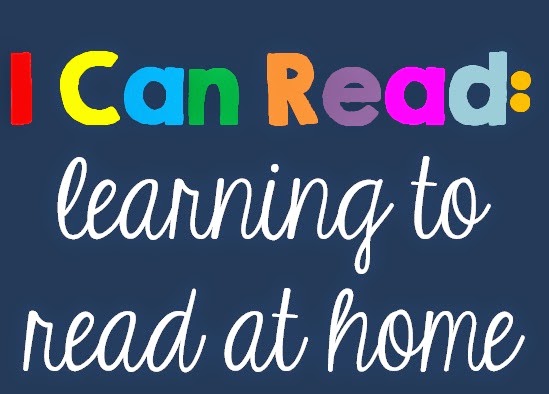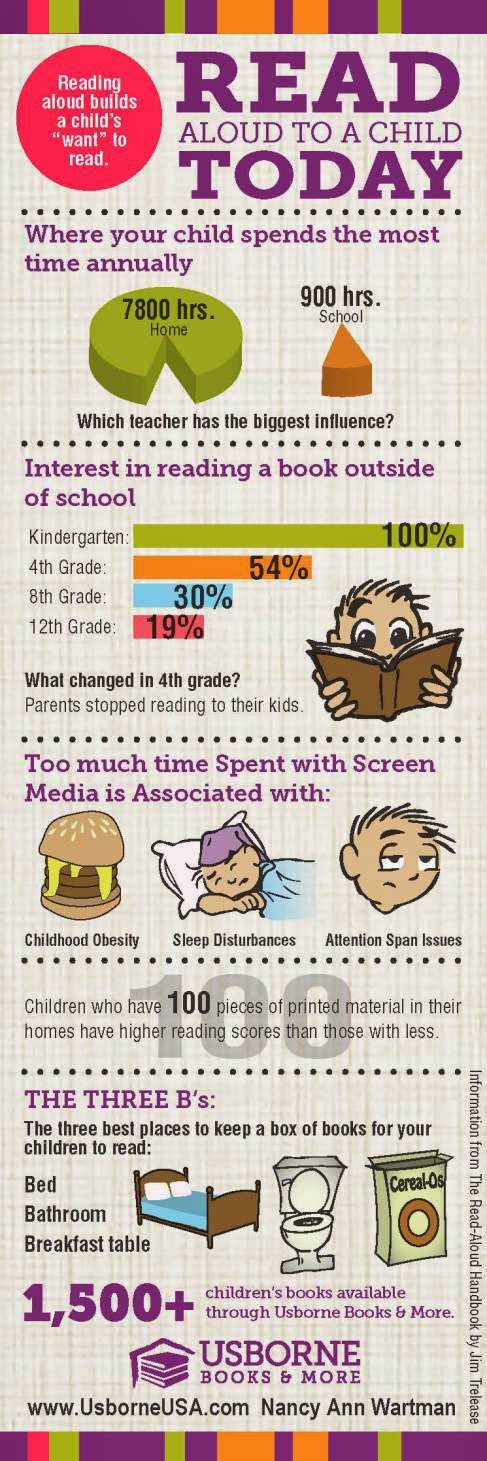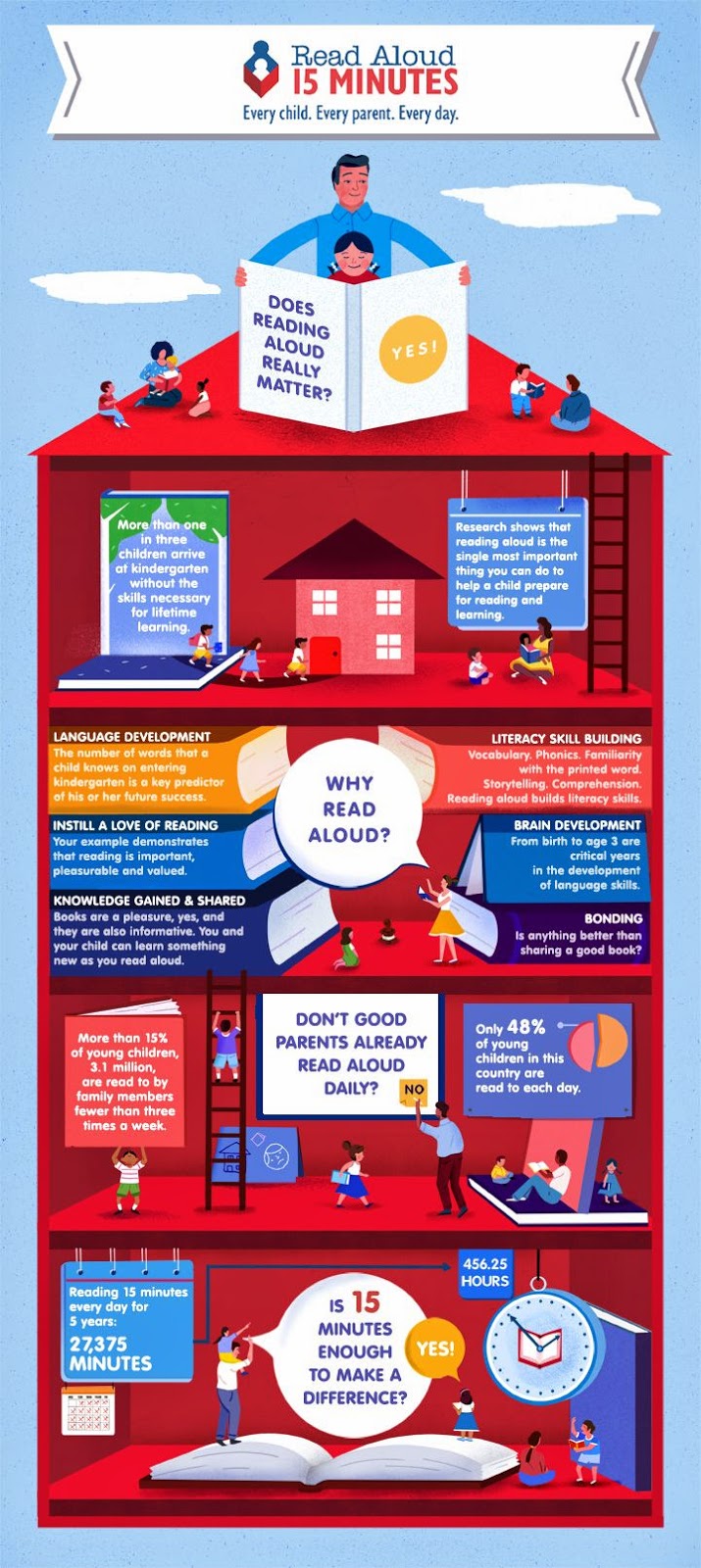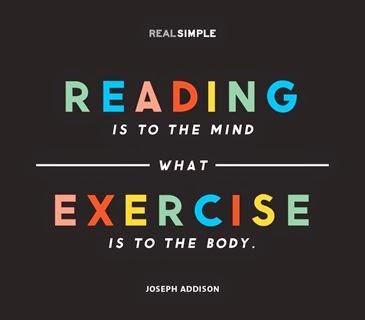Hands-down, my all time favorite thing to teach is reading. I especially love teaching children who are just learning to read. I taught Pre-K and Kindergarten for almost six years and cannot tell how rewarding it is to see little ones emerging as readers.
As a parent, you will be your child’s first, most consistent and most significant teacher.
“Parents are key reading role models. High frequency reading parents are six times more likely to have high frequency reading kids.” (2008 Kids & Family Reading Report)
“Parents are key reading role models. High frequency reading parents are six times more likely to have high frequency reading kids.” (2008 Kids & Family Reading Report)
At home you can focus on different kinds of reading.
1. Reading to your child.
Source: Nancy Ann’s blog
Your child needs to be read to consistently. This could be by a parent or other family member and I also like the idea of children listening to audio books that are accompanied with a book.
You can even find many audio readings of classics and favorites online on YouTube, AudioBooksforFree.com, Kids Learn Out Loud, Free Kids Books and Story Nory.
You can even record your voice and add photos (of the story or your own) as you read . This is a great option to have a ready to go narrated story of your child’s fave book.
The free app is called Adobe Voice and is ideal for iPads.
Visit your local library to see if they have regular shared readings.
How long you read with your child will depend on how old they are, how they are feeling on the day, their concentration span and what experience they have as a listener. If your child is not use to being read to, start small and make it achievable, even if it’s three minutes. Work on their concentration over a period of time. You can start reading to them from any age, even as babies.
Click here to download this poster.
The more a child is read to, the more ready they are to read themselves.
“Only one-third of all students entering high school are proficient in reading.” (NAEP Reading_2009)
2. Read with your child. Your child will show you when they are ready to read. You will notice that they want to join in with repetitive text, rhyme, ending sentences, predicting, questioning and repeating what you read.
Reading with your child is a time for you to guide them to understand the story and words and also pay attention to grammar and spelling.
– Before you read, ask them where the title is, the author and illustrator’s name is.
– Ask them to predict what will happen in the story and why.
– You could also ask them why they think someone would write such a story (moral, educate, help, entertain etc).
– Ask them if this book is a real story or just pretend.
– Show your child the correct way to turn pages, slowly and softly from the top right corner downwards.
Students who don’t read proficiently by third grade are four times more likely to leave school without a diploma when compared to proficient readers. ( The Annie E. Casey Foundation )
– Reading with your child can be fun. Read a particular word with your child and then ask them to find it in the picture (make sure it’s there). Point to the word and say, “This is the word ______ and here is the picture of a/the ___________.
– Question your child about character decisions and actions.
– Ask them what they think will happen on the next page.
– See if they can relate to the characters’ experiences to their own of a family member.
– Stop and re-read things that are hard to understand.
Fifteen-year-old students whose parents often read books with them during their first year of primary school show markedly higher scores in PISA 2009 than students whose parents read with them infrequently or not at all.
( Programme for International Student Assessment (PISA) )
( Programme for International Student Assessment (PISA) )
– Discuss how we take a big breath at the end of a period (full-stop) and a small breath at a comma.
– Point out that there are capitals at the beginning of each sentence.
– Show your child the speech marks and what they mean.
Discuss the reason for any other grammatical features such as speech bubbles, Capitalised words (yelling), italics, dashes and dots.
– As you read, be sure to use intonation (voice levels) and expression. Fluent readers are expressive and this is one of the desired skills you want to teach.
– As you read, you may like to pause for your child to finish the sentence or part of the sentence. This is easiest when the words are repetitive and or rhyming.
* I will elaborate on word activities you can do below in ‘Read words in context’.
– Read a variety of fiction and non-fiction books. Many times, we read lots of stories (fiction) but forget the factual books (non-fiction) which can be read in part over a few weeks.
– Read anything and everything. Invite your child to read one or two words in a newspaper or magazine. These could be repetitive words like the, is, most, because. Tell them the word or ask them if they know.
“Students who read widely and frequently are higher achievers than students who read rarely and narrowly.” (Scholastic: Classroom Libraries Work!)
– Have your child read words and numbers in their environment. Read street signs, building signs, door labels, park signs, words on cars and trucks and son on.
– Tell your child regularly what a great reader they are. You can also focus on specifics like, smooth reading, great expression, good concentrating, book care and so on.
“The performance advantage among students whose parents read to them in their early school years is evident regardless of the family’s socio-economic background.”
( Programme for International Student Assessment (PISA) )
( Programme for International Student Assessment (PISA) )
3. Listen to your child read independently. Your child will inherently read to themselves and especially when they are read to regularly. This is great for their confidence, empowerment, comprehension and fluency. Fluency is developed when a child’s reading sounds like talking and is smooth, expressive and self-regulated. Work on fluency skills by giving your children easy books that have familiar language and that may have read before. Fluency is the end goal of each level of reading.
“Reading frequency declines after age eight – and boys are more likely to be low frequency readers than girls.” (2008 Kids & Family Reading Report)
– Set aside some time in the day where your child is exposed to books in their own way. Don’t tell them to read for a given amount of time, it should come from them but there are ways to help them want to read. This may however change when they are required to read for homework but for children who are beginning school soon, it is vital that you don’t force them to read.
– Provide a space in their room that they have helped create. Set up a reading area/nook with old pillows, blankets, chairs and tables (or what ever they say that they want to add). Suggest to your child that they could read to their toys, dolls, bears and so on. It is important to involve them in the process. If at all possible provide your child with a mirror for them to look at themselves whilst they read.
– Set up audio books on your CD player or computer for them to read. Show them how to navigate the app, site or CD player. You will be surprised at how competent they will be after a few goes.
– Praise their independent reading ability by noting how you like their expression, clear voice, the way they held the book, stopped at periods etc. (all the things you do when you are reading with and to your child).
– Acknowledge that they’re not going to be reading in a conventional way. It is simply their interpretation and memory of reading. They will make up words and character names but that is perfect, don’t correct them.
– When children are reading independently, provide them with books that they have read before, especially the books that you have read together in the past week. Be sure to have non-fiction books available to them as well.
– Provide them with other reading material like old road maps, menus, bills, junk mail, instructions, recipes, calendars or old birthday cards. set this up in their reading area or on their book shelf or in a box.
– Praise their efforts at being independent and note their engagement and enthusiasm for reading. It is vital that children have confidence around reading and parents are often the first to help build this up.
4. Reading Words in Context. Reading a word or words in context seems easy enough but for children who are developing their reading skills and strategies it can be difficult as they have so much information to process. Many times, their emergent reading skills are just blossoming and they haven’t had as many opportunities to practice and refine them like we have. Our role in nurturing these skills and strategies is pivotal for their future success as a competent reader.
– Before you read a book to your child, look for a word that is written more than once. A sight word (a word that cannot be sounded out and is learnt by repetition) is a great start. If your child is at school, you might like to use one of the words from a list that they have brought home. You can write the word in large writing on a strip of paper. Tell your child that they are going to go on a word hunt or use the word itself; You are going on a ‘this’ hunt. See if they can scour each page for the word. When they find it, praise them and ask them to point to it and then read it out loud three times. You could do this is a funny robot, bear, mouse or daddy voice for fun. Read the book and your child holds the paper out and when you read the word, they match the paper strip to the word in the book. Keep on doing this for the rest of the book. After you have finished the story, place the word on the back of the door or somewhere close to where you read with them. As you read each week, you will increase the amount of words they are learning. Remember to go back and read them again every now and then. Remember that there are words that you can’t sound out, they are sight words and you can tell them the word if they pause for a length of time.
– Leave out words in the story for children to read.
– After you have read a book to your child, make one word with magnetic letters. Discuss the sounds that make that word.
– When you are reading words in the environment discuss meaning and who might of put that sign, poster of advertisement up and why.
– Use different reading materials and invite your child to try and read a word with you based on an illustration or the context of the writing e.g a chicken recipe, menu or a piece of junk mail.
– Decipher book titles by discussing the cover illustrations. If they observe a bear, ask them, “Where is the word bear?”
– When reading books with rhyme, read the two rhyming words and then make up or recall several other words that rhyme with these two words.
– When you read a word(s) that describes a person place or thing (adjective), ask your child to think of and verbally list other adjectives that could describe that thing.
– Read labels and packaging around the house, note the first sound and make it out loud for example, “Milk, m for milk, m makes an mmmmmmm sounds.” Can you make an “mmmmm sound?” “M for milk”. Ask your child to find m with their magnetic letters. Then ask them to find other things around the house that also begin with the mmmmmm sound. It would be fun to use the first sound in their name and surname and then family members’ names.
This stage sees the reader developing an extensive vocabulary which will assist them in becoming competent readers as they have the knowledge and experience with reading and understanding the word. This will also inherently inform their writing skills.
For more learn to read ideas, you might like to visit our Pinterest board; Learn to Read and Write.
5. Read words out of context. This is the final stage of the process. Your child is ready to read words that are in isolation and not necessarily in a book. This stage is recommended for when children have some phonological awareness meaning they are working on the sounds that letters make and the relationship sounds and letters have with each other. Your child will always use a meaning cue as you have established this foundation, now it is time to work on their phonological awareness skills. This will of course be taught at school but there are some fun things to do, that will help.
– Record words on a piece of paper with a highlighter. Ask your child to trace over the words and read them together. Ask them if they know the beginning sounds in each word.
– Write common words, names or new words on a piece of paper with a bold marker. Ask your child to trace over it with their finger and then use collage materials for the dollar store (confetti, stickers, buttons) to stick over the top of each letter in the word. Break down the sounds in the word with them.
– Invite your child to make their name or words out of play dough. Show them the techniques you use to roll out and form letters. Ensure that you have a sample of the word for them to look at and copy.
– Make a word using magazine and newspaper pages.
– Write ten words that you want your child to learn (see our free Dolch and Fry high frequency word lists here) each on one piece of paper. Take a photo of them holding up one word at a time. print out the photos and make them into a book or save them in a PowerPoint presentation file and replay them a few times throughout the week.
– Place chosen words on post it notes (one on each). Place them on some toy cars and race them down the hill to see which one wins.
– Write chosen words on balloons and play a game of tennis or just hit them around the room as you read and or spell them with the family.
In summary, your aim as your child embarks on the world of reading is first and foremost confidence and the desire to read for pleasure.
“Research has found a relation between the amount of time that children read for fun on their own and reading achievement.” (Handbook of Research on Teaching the English Language Arts)
You are your child’s catalyst for growth and self-esteem. I hope these ideas go along way to help you teach your child the first steps of reading.
This infograph also sums up learning to read at home.
resource: cleverclassroom

















Δεν υπάρχουν σχόλια:
Δημοσίευση σχολίου